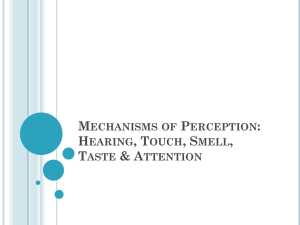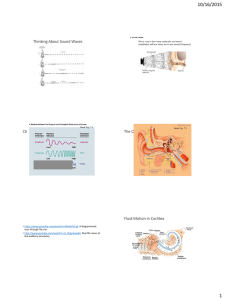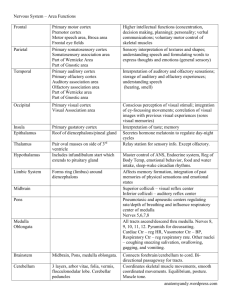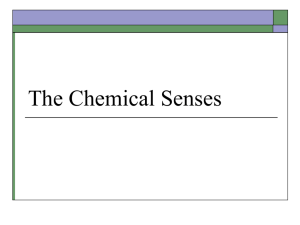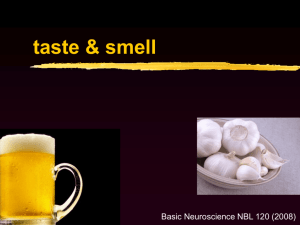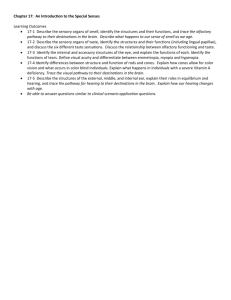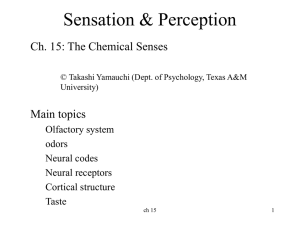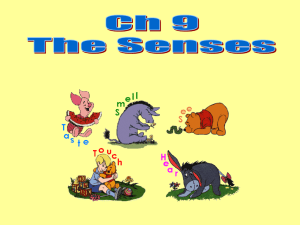Hearing, vestibular, taste and smell
advertisement
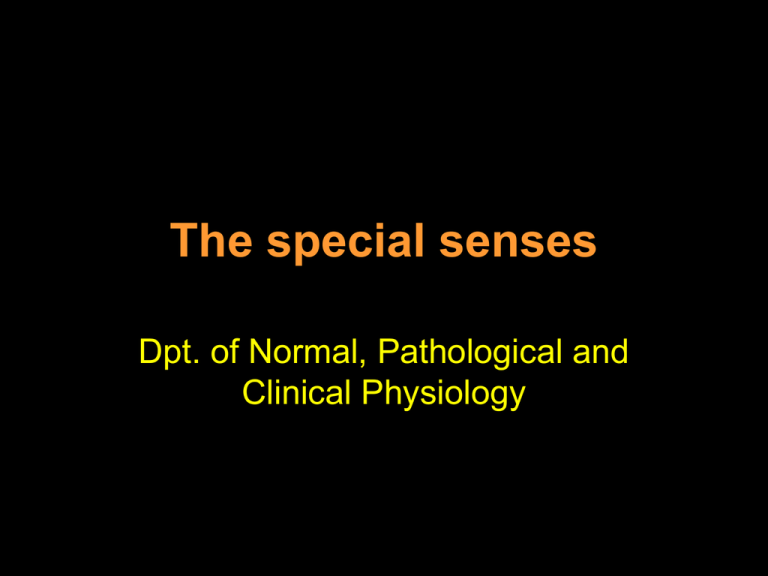
The special senses Dpt. of Normal, Pathological and Clinical Physiology CHAPTERS 1. 2. 3. 4. hearing vestibular apparatus taste smell HEARING • regular compression vawes • transmitted in air (300m/s), water (1500m/s), and in a solid • type of mechanical disturbances based communication (head vibration in snakes, lateral line in fish) • external, middle, inner ear terminology TONES AND BACKGROUND NOISE • pitch tone: sine curve – pitch of a tone: frequency – volume (loudness): amplitude • harmonic vibration : tone quality (timbre of sound) • noise: non-periodic terminology terminology DECIBEL • sound intensity Sound Pressure Level • range of hearing 20 microPa – 20 Pa – therefore decibel introduction • logarithmic unit SPL [dB] = 20 . log(px / po) where px is a measured value of acoustic pressure and po standard sound pressure 2.10-5 Pa terminology PHON subjective sound level depends on the frequency low frequency tone (60Hz) of the given sound pressure (90dB) is percieved like the reference tone having 80dB – 80 phons LOUDNESS OF COMMON SOUNDS jet engine 160 dB (pain) 140 dB (unpleasant) 120 dB metro 100 dB traffic 80 dB speech 60 dB whisper 30 dB EXTERNAL EAR • pinna (earlobe) and ear canal – act like a funnel and resonance chamber – localization of a source – amplification of the waves of specific f – in animals – mobile pinna MIDDLE EAR • • • • cavity in temporal bone, Eustachian canal ear drum, auditory ossicles, foramen ovale lever arm system: magnification of the sound pressure 30x tympanic reflex: contraction of m. tensor tympani and m. stapedius, stapes out, defense function, 0.1 s INNER EAR • bony labyrinth (os temporale), membranous labyrinth • cochlea: 35mm, 2 ¾ turns, divided by basilar and Reissner’s membrane into 3 chambers: the upper scala vestibuli and lower scala tympani (helicotrema, perilymph, foramen ovale, foramen rotundum); the middle scala media (endolymph, does not communicate) ORGAN OF CORTI • outer hair cells: 3 rows, 20000 • inner HCs: 1 row, 3500 = receptor • membrana tectorialis - tips of outer hair cells are embedded tonotopical organization of the cochlea AUDITORY PATHWAY • inner hair cells • ganglion spirale • ncl. cochlearis doraslis et ventralis in oblongata • olivary nuclei ipsi + contra • (nc. lateral lemnicsi) • colliculi inferiores (auditory reflexes) • corpus geniculatum mediale (thalamus) • primary auditory cortex (temporal, Brodmann 41) BAEP The thalamus (medial geniculate ganglion) and the auditory cortex (temporal lobe) make up the middle and late waves of the AEP. auditory nerve = wave I cochlear nuclei = wave II superior olive = wave III lateral lemniscus = wave IV inferior colliculus = wave V Waves I-V make up the brainstem AEP. BRAIN AREAS • frequency of APs is proportional to the loudness • tonotopical character through whole pathway (cohlea to cortex) LOCALIZATION OF THE SOURCE • timing – difference in latency between both ears (20 ms is enough), important for the tones under 3000 Hz • difference in loudness between both ears, over 3000 Hz VESTIBULAR APPARATUS • located in os temporale, formed by membranous labyrinth • 3 semicircular canals and 2 cavities (saculle and utricle) SACCULE AND UTRICLE • sensory organ macula, in utricle horizontally, in saccule ventrically • macula contains hair cells, gelatinous layer with CaCO3 crystals • genesis of AP • linear acceleration, gravitation SEMICIRCULAR CANALS • each widen at the end to form ampula • ampula contains cupula: analogous with macula (hair cells, excitated by the movements of endolymph) • angular acceleration Hair cells Vestibular nerve (Ganglion vestibularis) Ncc. vestibulares Vestibular ncc. efferents • Vestibuloocular III, IV, VI (oculomotor, trochlearis,abducens) • vestibulospinalis • Vestibulocerebellaris • VB complex – Sylvian fissure TASTE • • • Chemoreceptors distant chemical sense functions: 1. recognition of food, differentiation from poisons 2. strong coupling with behavior and emotions • the same for smell TYPES OF RECEPTORS • 13 types of taste receptors: – 2 receptors sodium, 2 kallium, 1 chlorine, 1 adenosin, 1 inosin, 2 saccharids, 2 bitter taste, 1 glutamate and 1 for H+ • beside them tactile and nociceptive receptors in mouth (V nerve) TASTE QUALITY • hundreds of tastes, maybe a result of combination of 4 basic (analogy with color vision) 1. sour taste 2. salt 3. sweet (sugar, glykol, ethanol, aldehyde, ketone, amide, 4. 5. AA, peptides) bitter (long chained substances containing nitrogeon, alkaloid - chinin, kofein, strychnin, nicotine) umami THRESHOLD VALUES • the lowest for the bitter taste (10-5 mol), the highest for salt and sweet (10-2 mol) • taste blindness fenylthiokarbamid (cabbage, broccoli): 30% RATIO • sweet: sucrose 1, 1-propoxy2-amino-4-nitrobenzen 5000, fructose 1.7, glucose 0.8, lactose 0,3 • salt: NaCl 1, NaF 2, CaCl2 1, NH4Cl 2.5, KCl 0.6 • sour: HCl 1, formic a. 1.1, butiric a. 0.85, citric a. 0.46 • bitter: chinin 1, strychnin 3.1, cofein 0.4, morphine 0.02 TASTE BUDS • 50 epithelial cells (taste and supporting cells) • taste pores, microvilli contains receptors, synapse nerves LOCALIZATION OF TASTE BUDS TASTE PATHWAYS • Buds • Facial nerve – Chorda tympani (ncc.) • Glossopharyngeal nerve (ncc.) • (vagus) • Tractus solitarius (gustatory ncc.) ----------• Thalamus (VB complex) • Sylvian fissure (SSA1) SMELL • low known sense: 1. subjective, cannot be studied in animals 2. not well developed in humans (?) • each nostril, surface area 2.4 cm2 OLFACTORY CELLS • • • • • • bipolar neurons, 100 millions olfactory hairs, contain receptors thousands of receptors, smell blindness Bowman’s glands: secretion of mucus ligand has to be water soluble G-protein coupled receptors (amplification: 1 ligand => several G-protein => more adenylcyclases => lot of cAMP) • absolute and recognition thresholds (garlic ADAPTATION • during first few seconds 50% • then slow and weak • important role of CNS (similar to taste) OLFACTORY PATHWAYS • axons of olfactory cells through lamina cribriformis to the bulbus olfactorius • synapse to the mitral cells (in glomerulus – segregation) • their axons via olfactory tract to the olfactory cortex (ncl. olf. ant., pyriform cortex, tuberculum olfactorium, amygdala, entorhinal cortex) and reticular formation (arousal) OLFACTORY CORTEX • ncl. olf. ant.: coordination of contralateral inputs • pyriform cortex: smell discrimination • amygdala: emotion • entorhinal cortex: memory processes • eliciting salivary and gastric secretion • hygiene monitor • social information • sexual behavior


